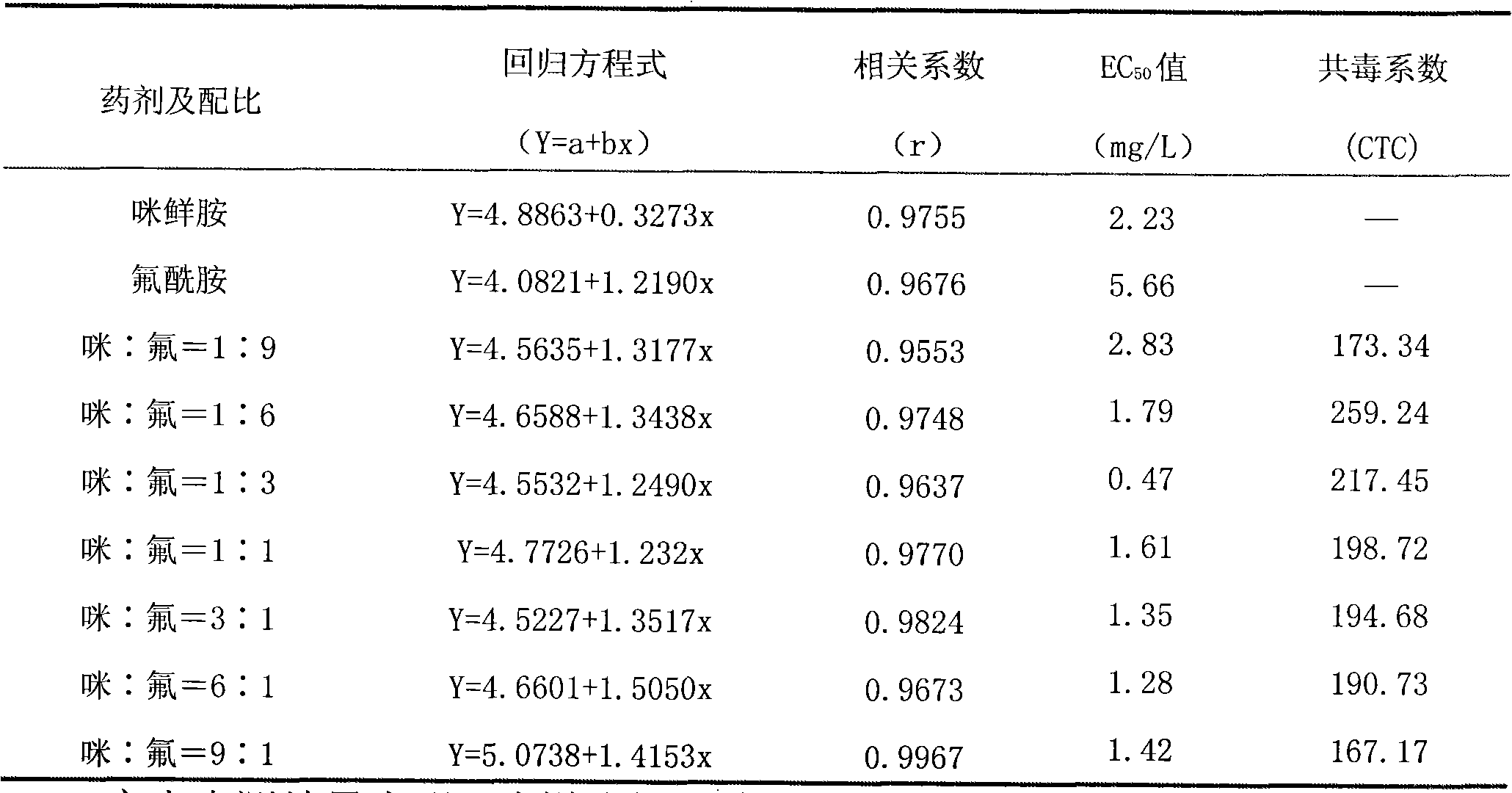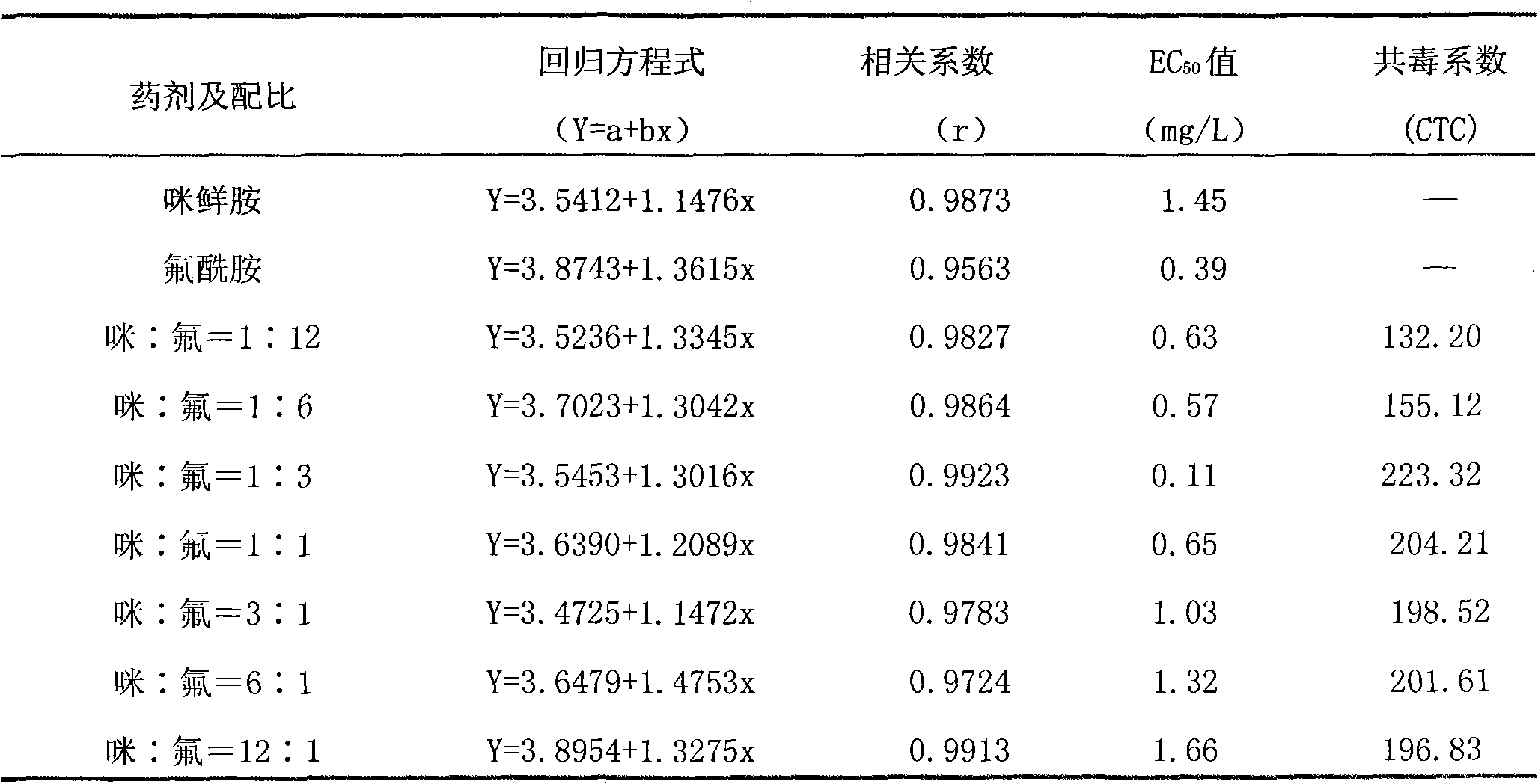Bactericidal composition containing prochloraz and flutolanil
A technology of composition and fluoroamide, which is applied in the direction of fungicides, biocides, biocides, etc., can solve the problems of unsatisfactory marketization, few applications, and narrow bactericidal spectrum, so as to reduce the dosage and cost of pesticides, Effects of reducing residue and improving bactericidal effect
- Summary
- Abstract
- Description
- Claims
- Application Information
AI Technical Summary
Problems solved by technology
Method used
Image
Examples
example 1
[0021] Physical measurement example 1: Toxicity determination of prochloraz and fluamide compound against rice bakanae disease
[0022] 1. Test object: rice bakanae disease (Gibberellafujikuroi (Sawada) Wr.)
[0023] 2. Test method: refer to "Pesticide Bioassay Test Guidelines NY / T1156.2-2006", and use the drug-containing medium method.
[0024] 3. Statistical analysis of data: use SAS6.12 statistical software for analysis. Calculate the mycelia growth inhibition rate (%) according to the test data, and obtain the virulence regression equation, correlation coefficient (r), EC 50 and co-toxicity coefficient.
[0025] 4. Evaluation method: Refer to "Pesticide Bioassay Test Guidelines NY / T 1156.2-2006", according to Sun & Johnson (1960) co-toxicity coefficient method (CTC) to evaluate the synergistic effect of drug mixing, that is, CTC ≤ 80 is antagonism, 80<CTC<120 is an additive effect, and CTC≥120 is a synergistic effect.
[0026] 5. Results and analysis
[0027] Table 1 ...
example 2
[0031] Physical Test Example 2: Toxicity Test of Prochloraz and Fluoramide Compound on Wheat Powdery Mildew Bacteria
[0032] 1. Test object: wheat powdery mildew [Latin scientific name: Blumeria graminis (DC.) Speer=Erysiphe graminis DC., Erysiphe graminis DC.f.sp.hordei Marcha.]
[0033] 2. Test method: refer to "Pesticide Bioassay Test Guidelines NY / T 1156.4-2006", and use the drug-containing medium method.
[0034] 3. Statistical analysis of data: use SAS6.12 statistical software for analysis. Calculate the mycelia growth inhibition rate (%) according to the test data, and obtain the virulence regression equation, correlation coefficient (r), EC 50 and co-toxicity coefficient.
[0035] 4. Evaluation method: Refer to the "Pesticide Bioassay Test Guidelines NY / T 1156.4-2006", and evaluate the synergistic effect of the drug mixture according to the co-toxicity coefficient method (CTC) of Sun & Johnson (1960), that is, CTC ≤ 80 is an antagonistic effect, 80
example 3
[0041] Physical measurement example 3: Toxicity determination of prochloraz and fluoroamide complex against triticale leaf rust
[0042] 1. Test object: Triticale leaf rust [Latin scientific name: ccinia recondita=P.ReconditaRoberge ex Desmaz.f.tritici]
[0043] 2. Test method: refer to the "Pesticide Bioassay Test Guidelines NY / T 1156.15-2008", and use the drug-containing medium method.
[0044] 3. Statistical analysis of data: use SAS6.12 statistical software for analysis. Calculate the mycelia growth inhibition rate (%) according to the test data, and obtain the virulence regression equation, correlation coefficient (r), EC 50 and co-toxicity coefficient.
[0045] 4. Evaluation method: Refer to the "Pesticide Bioassay Test Guidelines NY / T 1156.15-2008", according to Sun & Johnson (1960) co-toxicity coefficient method (CTC) to evaluate the synergistic effect of drug mixing, that is, CTC ≤ 80 is an antagonistic effect, 80
PUM
 Login to View More
Login to View More Abstract
Description
Claims
Application Information
 Login to View More
Login to View More - Generate Ideas
- Intellectual Property
- Life Sciences
- Materials
- Tech Scout
- Unparalleled Data Quality
- Higher Quality Content
- 60% Fewer Hallucinations
Browse by: Latest US Patents, China's latest patents, Technical Efficacy Thesaurus, Application Domain, Technology Topic, Popular Technical Reports.
© 2025 PatSnap. All rights reserved.Legal|Privacy policy|Modern Slavery Act Transparency Statement|Sitemap|About US| Contact US: help@patsnap.com



